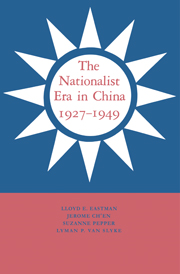Book contents
- Frontmatter
- Contents
- List of maps
- List of tables
- Preface
- Map 1 Provinces of China under the Republic
- Map 2 Republican China–physical features
- Chapter 1 Nationalist China during the Nanking decade, 1927–1937
- Chapter 2 The Communist movement, 1927–1937
- Chapter 3 Nationalist China during the Sino-Japanese War, 1937–1945
- Chapter 4 The Chinese Communist movement during the Sino-Japanese War, 1937–1945
- Chapter 5 The KMT-CCP conflict, 1945–1949
- Bibliography
- Index
Chapter 2 - The Communist movement, 1927–1937
Published online by Cambridge University Press: 27 January 2010
- Frontmatter
- Contents
- List of maps
- List of tables
- Preface
- Map 1 Provinces of China under the Republic
- Map 2 Republican China–physical features
- Chapter 1 Nationalist China during the Nanking decade, 1927–1937
- Chapter 2 The Communist movement, 1927–1937
- Chapter 3 Nationalist China during the Sino-Japanese War, 1937–1945
- Chapter 4 The Chinese Communist movement during the Sino-Japanese War, 1937–1945
- Chapter 5 The KMT-CCP conflict, 1945–1949
- Bibliography
- Index
Summary
The decade between the first and second united fronts, from the KMT-CCP break-up in mid-1927 to mid-1937, was a time of disaster, trial and tribulation for the Communist movement that brought it close to extinction. Yet from this period emerged an experienced and tested leadership with a capacity not only to survive but to win power. The severity of the problems met and surmounted by the CCP in these years can be best understood by looking first at its crisis of membership and organization.
RECONSTITUTION AND LEADERSHIP OF THE PARTY
In brief, the CCP from its Second Congress in 1922 had been a branch of the Communist International (CI) which, in spite of differing views occasionally expressed by Chinese leaders, had its way throughout the period of the first united front of 1923–7. After 1927, however, the prestige of the CI plummeted and vigorous efforts were needed to restore it. This meant the deposition and criticism of Ch'en Tu-hsiu, the recall and rebuke of Ch'ü Ch'iu-pai, the trial of Li Li-san; more significantly, this also meant the convocation of the Sixth Congress in Moscow and the reconstruction of the party presided over by Pavel Mif. From the autumn of 1927 to January 1931 the CI's interference in the affairs of the CCP virtually reduced the Chinese party to the status of a ‘colony’.
- Type
- Chapter
- Information
- The Nationalist Era in China, 1927–1949 , pp. 53 - 114Publisher: Cambridge University PressPrint publication year: 1991



